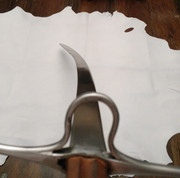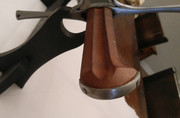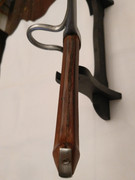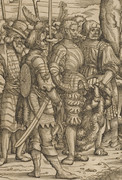| Author |
Message |
Ian Hutchison

Location: Louisiana / Nordrhein-Westholland Joined: 27 Nov 2007
Posts: 626
|
 Posted: Tue 02 Oct, 2018 4:03 am Post subject: Review: Landsknecht Emporium Landsknechtsabel Posted: Tue 02 Oct, 2018 4:03 am Post subject: Review: Landsknecht Emporium Landsknechtsabel |
 |
|
Just thought I'd give some of my initial impressions regarding a new messer I received today. This one is a light landsknechtsabel by Landsknecht Emporium (LE). In the style of something late-15th through mid-16th century I should guess. I'll update this review as I use the sword, and I should be able to do some cutting next week. I don't believe this landsknechtsabel is a direct reproduction of any specific example (correct me if I'm wrong!), but the style is in keeping with what can be seen in many period paintings and woodcuts, etc.
First off, communication and shipping with the gentlemen at LE has been fantastic. They answer promptly and at length. I ordered this sword because I am commissioning a custom piece with them, and wanted to get a feel for their work, and throughout the entire process they have been great to talk with and discuss the project. Once shipped, the sword reached me in the US in just three days and was very well packaged; wrapped in layers of foam sheet, shaped cardboard, and plastic wrap.
Stats:
OAL: 94cm (37in)
Mass: 867g (1.9lbs)
Grip: 15cm (6in)
Cross: 23cm (9in)
POB: 15cm (6in) from cross
My initial impression after unwrapping was of how light and naturally balanced the messer feels. I dare say it has already supplanted my Napoleonic flank officer's style saber as my best handling one-hander; despite that sword weighing 50g less. The landsknechtsabel moves easily, recovers quickly. There is very little effort required to make any kind of movement; whether accelorating or changing direction. The grip is well-shaped and comfortable, does not want to twist in the hand, and there is room enough for 1.5 hands, while the pommel shape makes it easy to use this way if desired.
Like other LE products which I have seen online, the level of finish on the messer is what might be called 'utilitarian'. Not everything is perfectly symmetrical or parallel. There are tool marks and scratches in various parts of the blade and pommel, remnants of scale on the guard, slightly uneven and messy leather seam on the grip. I don't mind this, try finding perfect symmetry on any original. Some swords are just weapons, pure tools; some are show-pieces; some are both. This is definitely one of the former, it seems to do what it needs to do wonderfully, with nothing extra. If it handled like a crowbar, this would be a different story, if any of the rough finish was unnecessary or embellished (remember those awful fake 'hammer marks' on everything early-2000s?) it would bother me, but this is all natural (organic?). Since it handles so well, I liken it to no-nonsense performance, no-nonsense appearance. Assembly seems good, everything is tight, nothing loose. Although there is quite a bit of gap between the guard and the blade, it has been filled with some kind of wax or resin (I'm curious as to what it is). So far quite pleased with the value, priority and attention were clearly given to performance.
I won't get to cut with it until next week, but the blade appears relatively sharp, as does the well-executed false edge (It did not cut paper out of the box, but does now after a few passes on a stone, also cuts milk jug just fine). The spine of the blade seems thin to my eyes (5mm at the shoulder, 4mm about 1/4 way down, then 3mm from last 1/3). I'm not sure what would be appropriate for historical one-handed messers, but I know two-handers and later sabers could be quite thick at the base of the spine. Despite the thin spine, the blade is stiff, there is no 'saw-blade' wobble. There is marked taper in the cross section of the blade from the spine toward the edge, and evident distal taper for the last third of the blade, especially with the false edge. I hope this translates into easy slices.
Although called the landsknechtsabel, I don't doubt this would be appropriate for civilian wear as well. It is has all the trappings of a good personal defense weapon: sufficiently 'serious' to get the job done, yet unobtrusive enough to be convenient. Whether boer or burgher, my initial impressions are that I wouldn't feel under-armed with this messer on my way to the market.










'We are told that the pen is mightier than the sword, but I know which of these weapons I would choose.' - Adrian Carton de Wiart
|
|
  |
 |
|
Adam Bodorics
Industry Professional
|
 Posted: Wed 03 Oct, 2018 4:54 am Post subject: Posted: Wed 03 Oct, 2018 4:54 am Post subject: |
 |
|
Thank you very much for the review and we're looking forward for your opinion after some cutting.
It indeed isn't a direct copy of any surviving original. We see this grip construction and cross on several Western European Messers/protosabers/etc (these are on a fine line where they could be called a lot of things, that's why we opted to call them Landsknechtsabel) with a variety of blades, including some with M4a blades. Those look remarkably similar to Easter European sabers from roughly the same period, even the width of the crosses are more than a bit similar, but obviously those sabers have 4c blades. As the two categories are so close in time&space, I wanted to see how an M4c blade would work on a more Western grip.
The black filler in the gap of the cross is cutler's pitch, so some beeswax&pitch melted together. The gap is semi-intentional - I did this pair while trying to think like a period cutler would, based on what we see on originals. That included picking up the closest drift I had and bashing it through the cross and then trying to solve the gap in an efficient way. As we mostly see these I-can-fit-a-ship-through-here gaps on pieces where all the organic hilt components are lost, I'm not quite sure how they did it - I hammered in some wooden wedges and following the advice of James Elmslie, we poured in some cutler's pitch to make it look neater.
These specific tool marks also have a lot to do with how I made these. I didn't want to use too many modern tools on it, so the blades were ground exclusively on wheels, all other stock removal was done with files. (pretty much all of our stuff has tool marks, and we try to keep them matching with what we see on originals, but this pair is a bit better in that regard) Later on I'd want to try doing the same, but preferably with a wheel matching the apparent radius of the grinding wheels we see in illustrations from the period.
Communication - we try our best in that regard, but sadly it's still a bit of a hit&miss. But our numbers are growing, so we miss less and less messages.
|
|
  |
 |
Ian Hutchison

Location: Louisiana / Nordrhein-Westholland Joined: 27 Nov 2007
Posts: 626
|
 Posted: Wed 03 Oct, 2018 7:56 am Post subject: Posted: Wed 03 Oct, 2018 7:56 am Post subject: |
 |
|
| Adam Bodorics wrote: |
The black filler in the gap of the cross is cutler's pitch, so some beeswax&pitch melted together. The gap is semi-intentional - I did this pair while trying to think like a period cutler would, based on what we see on originals. That included picking up the closest drift I had and bashing it through the cross and then trying to solve the gap in an efficient way. As we mostly see these I-can-fit-a-ship-through-here gaps on pieces where all the organic hilt components are lost, I'm not quite sure how they did it - I hammered in some wooden wedges and following the advice of James Elmslie, we poured in some cutler's pitch to make it look neater.
These specific tool marks also have a lot to do with how I made these. I didn't want to use too many modern tools on it, so the blades were ground exclusively on wheels, all other stock removal was done with files. (pretty much all of our stuff has tool marks, and we try to keep them matching with what we see on originals, but this pair is a bit better in that regard) Later on I'd want to try doing the same, but preferably with a wheel matching the apparent radius of the grinding wheels we see in illustrations from the period.
Communication - we try our best in that regard, but sadly it's still a bit of a hit&miss. But our numbers are growing, so we miss less and less messages. |
Thanks Adam, I really love historic assembly methods, which you seem to try in all your models (sliding guard over blade, correct nagel etc.). I have of course heard about wood and metal shims, but cutler's pitch is new to me, very interesting and smells excellent. Your stuff looks right, not every sword was meant for a king; messers/bauernwehr can be found for all social classes and their finish/cost would reflect that.
When I first started collecting, I judged everything by Albion. I wanted laser precision, 'perfection'. Recently, I really start appreciating 'imperfections' that come from something being made by hand and eye using historical methods. Also, swords/weapons of the common people (volksschwert?) are increasingly attractive, especially those of the late middle-ages/early-renaissance (falchions, messers, tessaks/dussacks, katzbalgers etc.). For one they are academically interesting, secondly I can't really justify the expense of accurate reproductions of many 'finer' weapons (as much as I would like to own a Barta, €2000 is too rich for me!).
Speaking of tessaks, I see you made some in the past, will you ever make more?
'We are told that the pen is mightier than the sword, but I know which of these weapons I would choose.' - Adrian Carton de Wiart
|
|
  |
 |
Ian Hutchison

Location: Louisiana / Nordrhein-Westholland Joined: 27 Nov 2007
Posts: 626
|
 Posted: Thu 09 May, 2019 7:22 pm Post subject: Posted: Thu 09 May, 2019 7:22 pm Post subject: |
 |
|
Just a quick update. I've now done a fair bit of cutting of light targets with the saber and its performance is really outstanding. It is light in the hand without being flimsy, recovers and turns quickly, and came very sharp right out of the box. Control is excellent, usually I can get 3-4 cuts out of a milk jug, with this sword I can reduce almost inch by inch.
Hats off to LE, really looking forward to receiving the next piece I have on order with them and hope there are many more to come.
'We are told that the pen is mightier than the sword, but I know which of these weapons I would choose.' - Adrian Carton de Wiart
|
|
  |
 |
|
|
You cannot post new topics in this forum
You cannot reply to topics in this forum
You cannot edit your posts in this forum
You cannot delete your posts in this forum
You cannot vote in polls in this forum
You cannot attach files in this forum
You can download files in this forum
|
All contents © Copyright 2003-2025 myArmoury.com — All rights reserved
Discussion forums powered by phpBB © The phpBB Group
Switch to the Basic Low-bandwidth Version of the forum
|

